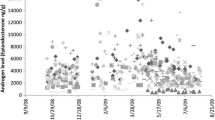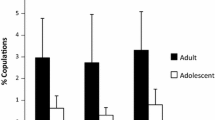Abstract
A captive group of rhesus macaques (Macaca mulatta) was observed during the breeding season to determine if consortship behavior, rather than promiscuous matings, resulted in higher reproductive success for either partner. The 38 adult females in this group were observed “in consort” with the 5 adult or 4 subadult males on 179 occasions. Most of these consortships were short-term, lasting less than one day. Six females engaged in consortships with one male that spanned more than three days, but the majority of these long-term associations did not result in a pregnancy with that male. The term “consortship” has been traditionally accepted as a specific nonhuman primate mating pattern, but the exact nature of this behavioral pattern and its evolutionary importance have been less clearly understood. Consort behavior could be considered a precursor to a monogamous mating system if long-term exclusive sexual associations resulted in higher reproductive success for the participants. But this study demonstrates that for rhesus macaques, who exhibit both consort behavior and more promiscuous matings, there is no clear reproductive advantage to long-term consortships. In light of the inconsistent use of the term consortship, the possible adaptive significance of an exclusive male-female sexual association for the evolution of human mating patterns needs to be reevaluated.
Similar content being viewed by others
References
Alexander, R. D. &K. M. Noonan, 1979. Concealment of ovulation, parental care, and human social evolution. In:Evolutionary Biology and Human Social Behavior,N. A. Chagnon &W. Irons (eds.), Duxbury Press, North Scituate, pp. 436–453.
Berenstain, L., P. S. Rodman, &D. G. Smith, 1981. Social relations between fathers and offspring in a captive group of rhesus monkeys (Macaca mulatta).Anim. Behav., 29: 1057–1063.
Blaffer Hrdy, S., 1981.The Women That Never Evolved. Harvard Univ. Press, Cambridge.
———— &P. Whitten, 1986. The patterning of sexual activity. In:Primate Societies,B. B. Smuts,D. Cheney,R. Seyfarth,R. Wrangham, &T. Struhsaker (eds.), Univ. of Chicago Press, Chicago, pp. 370–384.
Carpenter, C. R., 1934. A field study of the behavior and social relations of howling monkeys (Alouatta palliata).Comp. Psych. Monog., 10: 1–168.
————, 1942. Sexual behavior of free-ranging rhesus monkeys (Macaca mulatta).J. Comp. Psychol., 33: 113–142.
Conaway, C. H. &C. B. Koford, 1964. Estrous cycles and mating behavior in a free-ranging band of rhesus monkeys.J. Mammal., 45: 577–588.
Cox, C. R. &B. J. Leboeuf, 1977. Female incitation of male competition: a mechanism in sexual selection.Amer. Naturalist, 111: 317–335.
Glick, B. B., 1980. Ontogenetic and psychological aspects of mating activities of maleMacaca radiata. In:The Macaques,D. G. Lindburg (ed.), Van Nostrand Reinhold, New York, pp. 345–369.
Goodall, J., 1986.The Chimpanzees of Gombe. Belknap Press, Cambridge.
Gouzoules, H., S. Gouzoules, &L. Fedigan, 1983. Male Japanese monkey mating strategies: Are female reproductive-state cues available?Amer. J. Primatol., 4: 345.
Harding, R. S. O. & D. Olson, in press. Patterns of mating among male patas monkeys (Erythrocebus patas) in Kenya.Amer. J. Primatol.
Hausfater, G., 1975.Dominance and Reproduction in Baboons (Papio cynocephalus). Karger, Basel.
Jolly, A., 1966.Lemur Behavior. Univ. of Chicago Press, Chicago.
Kaufmann, J. H., 1965. A three-year study of mating behavior in a free-ranging band of rhesus monkeys.Ecology, 46: 500–512.
Lindburg, D. G., 1971. The rhesus monkey in North India: An ecological and behavioral study. In:Primate Behavior,L. A. Rosenblum (ed.), Academic Press, New York, pp. 2–106.
————, 1983. Making behavior and estrus in the Indian rhesus monkey. In:Perspectives in Primate Biology,P. K. Seth (ed.), Today and Tomorrow's Printers & Pub., Delhi, pp. 45–61.
Lovejoy, C. O., 1981. The origin of man.Science, 211: 341–350.
Loy, J., 1971. Estrous behavior of free-ranging rhesus monkeys (Macaca mulatta).Primates, 12: 1–21.
Mason, W. A., 1966. Social organization of the South American monkey,Callicebus moloch; A preliminary report.Tulane Stud. Zool., 13: 23–28.
Mitani, J. C., 1985. Mating behavior of male orangutans in the Kutai Game Reserve, Indonesia.Anim. Behav., 33: 392–402.
Saayman, G. S., 1970. The menstrual cycle and sexual behavior in a troop of free-ranging chacma baboons (Papio ursinus).Folia Primatol., 12: 81–110.
Scott, L. M., 1984. Reproductive behavior of adolescent female baboons (Papio anubis) in Kenya. In:Female Primates, Studies by Women Primatologists,M. F. Small (ed.), Alan R. Liss Inc., New York, pp. 77–102.
Siegel, S., 1956.Nonparametric Statistics. McGraw-Hill, New York.
Small, M. F., 1982. A comparison of mother and nonmother behaviors during birth season in two species of captive macaques.Folia Primatol., 38: 99–107.
————, 1983. Females without infants: Mating strategies in strategies in two species of captive macaques.Folia Primatol., 40: 125–133.
————, 1988. Female primate sexual behavior and conception; Are they really sperm to spare?Cur. Anthropol., 29: 81–100.
----, in press. Promiscuity in Barbary macaques (Macaca sylvanus).Amer. J. Primatol.
———— &D. G. Smith, 1985. Sex of infants produced by the male rhesus macaques.Amer. Naturalist, 126: 354–361.
———— & ————, 1986. The influence of birth timing upon infant growth and survival in captive rhesus macaques (Macaca mulatta).Int. J. Primatol., 7: 289–304.
Smith, D. G., 1982. Use of genetic markers in the colony management of nonhuman primates; A review.Lab. Anim. Sci., 30: 540–546.
Smuts, B. B., 1985.Sex and Friedship in Baboons. Aldine, New York.
Sugiyama, Y., 1971. Characteristics of the social life of bonnet macaques (Macaca radiata).Primates, 12: 247–266.
Stern, B. R. &D. G. Smith, 1984. Sexual behavior and paternity in three captive groups of rhesus monkeys (Macaca mulatta).Anim. Behav., 32: 23–32.
Strassman, B. I., 1981. Sexual selection, paternal care, and concealed ovulation.Ethol. & Sociobiol., 2: 31–40.
Taub, D. M., 1980. Female choice and mating strategies among wild barbary macaques (Macaca sylvanus L.). In:The Macaques,D. G. Lindburg (ed.), Van Nostrand Reinhold, New York, pp. 287–334.
———— &W. K. Redican, 1984. Adult male-infant interactions in Old World monkeys and apes. In:Primate Paternalism,D. M. Taub (ed.), Van Nostrand Reinhold, New York, pp. 377–406.
Terborgh, J. &A. W. Goldizen, 1985. On the mating system of cooperatively breeding saddleback tamarin (Saguinus fuscicollis).Behav. Ecol. & Sociobiol., 16: 293–299.
Tutin, C. E. G. &P. R. McGinnis, 1981. Chimpanzee reproduction in the wild. In:Reproductive Biology of the Great Apes,C. E. Graham (ed.), Academic Press, New York, pp. 239–264.
Tutin, J., 1979. Mating patterns and reproductive strategies in a community of wild chimpanzees (Pan troglodytes schweinfurthii).Behav. Ecol. & Sociobiol., 6: 29–38.
van Noordwijk, M. A., 1985. Sexual behavior of Sumatran long-tailed macaques (Macaca fascicularis).Z. Tierpsychol., 70: 277–296.
Wrangham, R. W., 1980. An ecological model of female-bonded primate groups.Behaviour, 75: 262–300.
Author information
Authors and Affiliations
About this article
Cite this article
Small, M.F. Consortships and conceptions in captive rhesus macaques (Macaca mulatta). Primates 31, 339–350 (1990). https://doi.org/10.1007/BF02381105
Received:
Accepted:
Issue Date:
DOI: https://doi.org/10.1007/BF02381105




